
If you wish this
program to be sent to your or your friends e-mail address,
please get a subscription (totally free of charge, and no
advertisements will be sent).
I would like to
get a subscription to
The Fourth Dimension in
Landscape Design>>>>>>>
I would
like to propose for my friend>>>>>>
|
Palm Centre Plant of the
Month December
2008 |
|
There are around 190 different species of Dombeya of
which 7 are found in the wild in South Africa.
This is one of them, Dombeya burgessiae, a
small tree and a member of the Sterculiaceae family. |
|
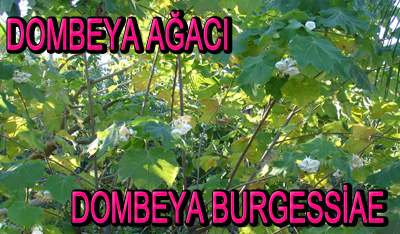 |
|
DOMBEYA TREE - DOMBEYA
BURGESSİAE
Dombeya burgessiae,
also known as Wild Pink Pear, is found in the wild in
Africa from Kwazulu Natal in the south up to Tanzania
across a wide geographic region. In the wild it
grows on the edge of forests, in mountainous or hilly
areas and along river valleys. The name Dombeya
comes from the plant collector Joseph Dombey who
discovered it and also collected many plants from South
America.
It is a small tree rarely growing to more than 4 metres
in height with a span of 4 metres. In a small
garden it is a good specimen tree and works in groups in
larger gardens. It will grow in full sun or
partial shade. It has large green, lobed leaves
which are soft and resemble grape vine leaves. It
flowers in October November with its pink or white
flowers giving colour to the winter garden.
Flowers left on the tree will die and turn a light brown
in colour as they dry. Once dried they can be
picked with their stems and used in dried flower
displays indoors.
Dombeya trees are fast growing, once planted in the
ground they reach maturity in 3 4 years. They
withstand dry periods and light frost. At the Palm
Centre these trees have experienced -60C at
which point they lose their leaves but these grow back
again the following summer. They grow from seed
which germinates easily and the young plants grow
quickly.
In terms of landscape design this tree can be used as a
specimen or several may be grouped together anywhere in
the Mediterranean region of Turkey. When most
trees have lost their leaves for the winter and hardly
anything is in flower, dombeya attracts attention with
its pink white flowers. As it can grow in shade
you could even plant it underneath taller trees. |
|
Palm Centre Plant of the
Month
October 2008 |
|
The euphorbias are a very large family
which includes both succulent and non-succulent type
plants. It has over 2000 species which in general
are found in temperate and hot regions of the globe.
Some of them grow like grasses, others like
multi-stemmed shrubs whilst some reach tree proportions,
many of them can be taken for cactus on a first glance.
The Euphorbus from whom they take their name lived in
the 1st century and was doctor to King Juba
of Mauritania. It is known that Euphorbus used the
plants that now bear his name for their medicinal
properties. The species name tirucalli
comes from the region of Malabar in south India, and was
given to this plant in 1753 by Linnaeus within his
comprehensive classification of plant names. |
|
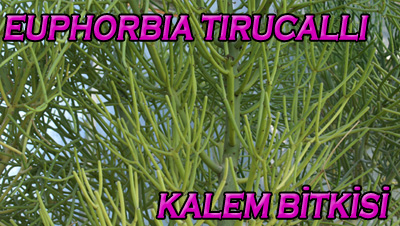 |
|
EUPHORBIA TIRUCALLI:Pencil
plant, Deers antler plant
The Pencil Plant (Euphorbia tirucalli) is
a multi-branching succulent. It is native to
tropical regions of east and south Africa. Outside
of Africa it can be found in India, China, Indonesia and
the Philippines and the fact that it is encountered in
so many different countries, would seem to support the
idea that it has long been known as a useful plant.
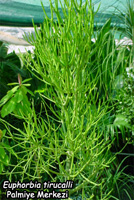
It can grow from 3 5 metres up to as high as 10.
The young trunk and branches are green but as they age
they become grey and develop a rough-looking surface.
The green branches are smooth, unblemished and
cylindrical in form with tiny cylindrical leaves a
maximum of 12 x 1.5mm in size. Leaves only stay on
the plant for a short time after which it presents as a
trunk and branches only. For this reason it is
sometimes known as the Naked English Lady plant.
As the plant can photosynthesise via its green trunk and
branches it actually has no need of leaves.
Almost insignificant small yellow tufted flowers open on
the newest branches from April to June. One to two
months after flowering, round fruits some 10 12mm in
diameter appear attached to the branches by a short
stem. Inside the fruits brown oval seeds are
found.
The trunk and branches of this plant are filled with a
white liquid which emerges when they are damaged in any
way. This latex-like liquid is toxic and most
people will have some form of allergic reaction to it.
In particular it is vital that the liquid not come into
contact with eyes, mouth or nose.
The plant is ideal for arid conditions. It not
only withstands drought well but also rejuvenates itself
rapidly following long periods without water. In
the tropics it is often used as a hedging plant.
Animals and birds are aware of its toxicity and leave it
well alone.
The latex contained in euphorbia tirucalli is partially
hard rubber and partially a resin, and it has no great
value. There have been experiments to try and
produce biodiesel from the substance and, for this
reason, the plant is sometimes called the Petrol
Plant.
It is a good plant for indoors, except where small
children could come into contact with its toxic latex.
In Mediterranean gardens it can be used in very
sheltered conditions. It can be grown from seed or
cuttings which root rapidly and can withstand drought,
but will not survive where the temperature drops below 0oC.
Any serious frost will kill this plant. |
|
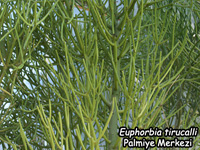 |
|
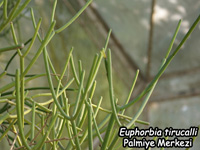 |
|
Palm Centre Plant of the
Month
September 2008 |
|
This month we introduce you to Ensete ventricosum
a showy plant found in the warmest places in
Mediterranean gardens. It is also known as the
Abyssinian Banana and belongs to a genus of six species
all native to tropical regions of the Old World.
It is related to the edible bananas. It cannot
stand even the slightest frost so cannot survive in a
winter garden. If you get frost in your garden you
have to grow it in a pot and bring it indoors in the
winter. It is widely used in landscaping schemes
for the tropical note it brings to the garden with its
wide leaves featuring red stems and veins. |
|
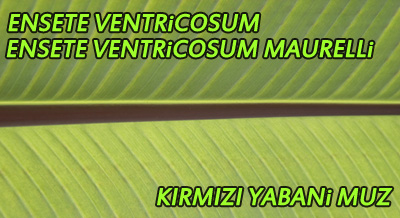 |
|
ENSETE
VENTRICOSUM:
ABYSSINIAN BANANA
Ensete ventricosum
is found in the wild all over Africa and can grow to
8-10m. It does not have a trunk, but grows from a
false trunk formed by the stems of dead leaves from
which no branches grow. This false trunk is at its
widest at the point where it meets the soil and the
plant is named for this as ventricosum means swollen
in Latin. The plant usually has only one false
trunk but occasionally off shoot suckers may be
emerged. The plant is wide and grows to several
metres in height with long green leaves of which the
thick stems and central veins are rosy pink.
Thinner veining in the leaves will also be a lighter
pink.
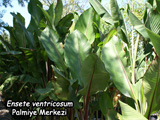
It is a monocarpic plant which means it dies after
flowering. It produces large flowers which, with
their stem, can reach 2-3m in length. The male
flowers are produced at the top of the stem, the females
lower down. Flowers are cream in colour and are
only produced when a plant is over eight years of age.
Flowering occurs at the beginning of summer. After
flowering a banana-like fruit is produced with yellow
skin covered in black spots. In the fruit will be
found rows of hard black seeds the size of chick peas.
As well as being grown for ornamental purposes, in
countries where the plant is native the fruit is eaten.
The large flowers are also cooked and eaten. Also
the inner segments of leaves from the trunk are cooked
and eaten. In Ethiopa where famine is often an
issue, people even eat the large seeds. The leaves
are used as roofing material.
Entese ventricosum
is grown from seed. If offshoot succers occurs, it
can be split to give separate plants. It likes
full sun or dappled shade, humus-rich soil and lots of
water. The slightest touch of frost will damage
the plant. In areas where frost is likely it
should either be planted under other trees for
protection or brought indoors in the winter.
Entese ventricosum maurelli Red Abyssinian Banana
this is a variety rarely produced from normal
Ensete ventricosum seed which grows with red
leaves and is known as Entese ventricosum
maurelli.
Apart from the difference in leaf colour it is
identical in terms of care and behaviour to the parent
plant. Indeed seed from this when planted will
revert to the usual green-leafed Ensete
ventricosum. |
|
|
Palm Centre Plant of the
Month
August 2008 |
|
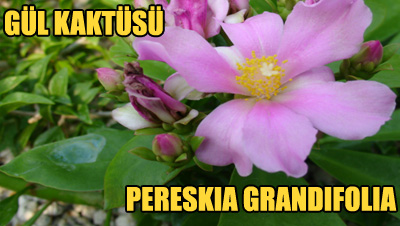 |
|
PERESKİA
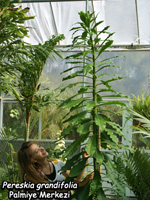
The Pereskias are a family of primitive cacti
comprising 16 varieties. They grow as trees,
climbers or shrubs and are found in Florida, Mexico,
Central America, tropical regions of South America where
they grow in forests under the shade canopy. The
shrub form generally reaches a height of 1m, whilst
climbers and trees can grow to 5 20m. It is a
long-lived perennial whose soft thorny branches will,
over time, take on the appearance of hardened wood.
Some Pereskia grow from rhizomes. They
generally have long oval leaves but there are types with
a round leaf. They are evergreen except for some
varieties that shed their leaves during periods of
dormancy. Their flowers resemble wild roses and
can be found in single or double format.
Pereskias
withstand damp much more readily than other forms of
cactus and if grafted on to Zygocactus root stock can
form miniature trees.
Pereskia grandiflora : Cactus Rose
Native to south east Brazil this is a shrub or small
tree. It is usually used as a decorative tree
which can grow to 2 5m. Its grey/brown trunk can
reach a diameter of 20cm.
On the trunk and branches small round areas can be seen
(these are specific to cactus) which on the branches
will be 3 5mm, but can be up to 12mm on the trunk,
from which brown feathery hairs are produced which
eventually become thorns. From one such area on
the trunk as many as 90 thorns each 3-5cm in length may
appear.
Pereskia grandiflora can be treated as all other cactus,
it does not need any special care. It likes lots
of light and can be grown from seed or cuttings.
All pereskias are tender and will not withstand any
frost. In places where frost is expected they
should not be planted directly in the garden. |
|
Palm Centre Plant of the
Month
July 2008 |
|
This month wed like to introduce you to Eucomis
also known as the Pineapple Flower plant.
It is not widely known in Turkey and, as far as we are
aware, can only be bought at the Palm Centre.
However, it is hardy, low maintenance, disease resistant
and, with its striking flowers, will add colour and
interest to any garden. |
|
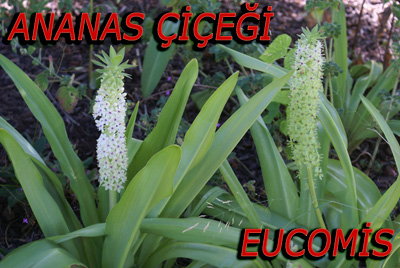 |
|
EUCOMIS : PINEAPPLE FLOWER
Eucomis are a group of 15 varieties of deciduous plants
native to South Africa. They grow from bulbs, are
perennials and are very long-lived. They produce
flowers on a tall stem where tiny star-like flowers
cover the length of the stem. It is from this
flower stem, and the shape of the leaves, that it gets
its common name Pineapple Flower.
Eucomis
will stand slight frost, loses its leaves in winter and
does not need much water. If these conditions
dont match your garden, then it can be potted up for
the winter and taken indoors.
It can be grown from seed, or from bulbs split off from
established plants. It can also be propagated from
leaf cuttings. Bulbs should be planted 15 cm below
the surface. Soil should be rich in humus and well
draining. It is happy in full sun or partial
shade.
Eucomis autumnalis:
has leaves up to 45 cm in length and produces a very
long stem studded with countless greenish-white flowers
which open in summer or early autumn. The bright
green leaves have curly edges.
Eucomis comusus:
grows to 70 cm and has light green leaves with almost
purple undersides. The leaves have wavy edges and
the 30 cm flower stem has greenish-white flowers which
may also have pink stains upon them.
Eucomis bicolour:
has leaves 30 50 cm long similar to those described
above. It produces a brown flower stem with light green
flowers whose petals have purple edges. |
|
Palm Centre Plant of the
Month
June 2008 |
|
The pistacias are members of the Anacardiaceae or
Mango family. There are 11 different varieties of
pistacia some deciduous and others evergreen.
Various varieties are native to the Mediterranean,
Central Asia, Malaysia, Japan, Europe and Mexico. |
|
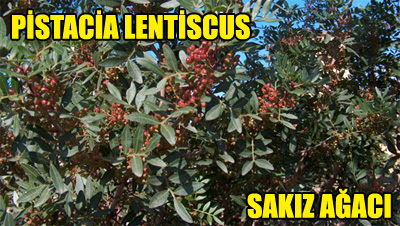 |
|
Pistacia chinensis (Chinese mastic tree):
Frequently used in landscape schemes this tree is native
to central and western China. In spring it has
sweet smelling red flowers and in autumn its leaves turn
red before dropping.
Pistacia atlantica:
Found in western Anatolia and locally known as mineç
this is a big showy tree. Its young shoots are
used as vegetables.
Pistacia terebinthus:
Native to eastern Mediterranean countries this is a
deciduous tree. A form of turpentine is made from
the sap of the tree. Turpentine is also extracted
from pine trees. It is used in paint and varnish
factories as well as other forms of manufacturing.
The tree has greenish flowers which open between April
and June and it grows to anywhere between 2 6m in
height. Its fruits start off red in colour then
turn brown and resin from these fruits produces both
stable and volatile oils.
Villagers call this tree menengiç and folk medicine
uses its leaves for their antiseptic properties, in
treatment of peptic ulcers and also for the relief of
sunburn. The fruits are used as a diuretic and an
expectorant.
Pistacia lentiscus (Mastic tree):
Native to the Mediterranean region and sometimes called
the green pistacia. It is an evergreen and can
be a large shrub or a small tree with a single trunk, or
multiple trunks. It can grow to 5m in height.
From cuts in the trunk a scented liquid called mastic
is collected. This is claimed to cleanse the
mouth and is used in medicines. It is also used to
scent cakes, jams and ice creams.
Pistacia lentiscus var. latifolius
A variety only found on Sakiz Island and along the Çeşme
peninsula. It can grow to 10m in height and is
evergreen. Cutting the branches of this tree
produces Mastic Drops which are used to cure stomach
aches or diarrhea by villagers. |
|
Palm Centre Plant of the
Month
May 2008 |
|
Whilst most of the plants we feature as Plants of the
Month are new to Turkey, we do believe that more
attention should be given to plants which are native to
Turkey and, from time to time, we focus on such
specimens. This month and next we are featuring
two plants native to the Mediterranean region, often
encountered in the wild and yet, we believe, not used as
much as they could be in our gardens: the myrtle and
mastic trees. |
|
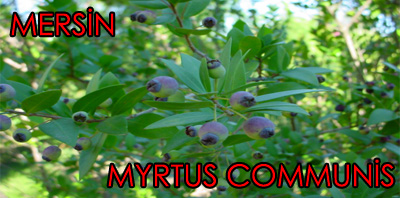 |
|
Myrtle
MYRTUS COMMUNİS
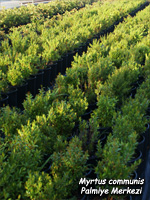
We will consider two types of myrtle found within the
Myrtaceae family. Both are found in the wild in
southern Europe and north Africa, and are evergreen,
large shrubs reaching a height of 3 5 metres.
In the southern hemisphere there are other types of
myrtle such as Lophomyrtus, Luma and Ugni.
Of our two types one is native to northern Africa,
particularly Algeria and Chad and is called the Sahara
Myrtle or Myrtus nivelli.
In
our country the other type, Myrtus communis (mersin in
Turkish) is found. It is an aromatic plant.
Its oval leaves, 3 5cm in length, release a pleasant
smell when crushed in the hand. It has white,
star-shaped flowers, with five petals, five sepals and
numerous stamens. It makes blue-black berries
which contain many seeds.
Myrtle not only features in Greek mythology, but is also
an important plant in the context of rural life in our
own country. According to the myths Aphrodite
(Venus) was born on the island of Cyprus then rode on a
wave to Cnidos near Datça
where she emerged from the sea naked and hid behind a
myrtle bush. To this day people in the
Mediterranean region of Turkey, on religious holidays
and other special occasions, visit the graves of their
dead and lay myrtle branches and leaves upon them.
Myrtle berries are edible and, because of their special
aroma, are added to jams or even made into an
exclusively myrtle berry preserve. Many herbal
remedies include the berries.
Because of its bright green leaves, beautiful flowers,
interesting fruit and its ability to withstand the long,
dry summers myrtle deserves to be more widely used in
gardens. It is a crucial element of any natural
Mediterranean garden. It can be planted alone or
in groups, and used as hedging. It is propagated
from seeds planted in the autumn or spring, or from
half-hard cuttings taken in summer. It needs full
sun and good draining soil but will withstand
temperatures down to -8 or -10oC.
Nowadays there are many new hybrid varieties of myrtle
including a Compact Form with small leaves and
branches; Flore Pleno which has double white
flowers; Microphylla whose leaves and flowers are
tiny; Variegata which has leaves edged in white;
Tarentina which has thin, needle-like leaves and
creamy white flowers. |
|
Palm Centre Plant of the Month
April 2008 |
|
This month we want to introduce you to a plant that
first made its appearance in this country many years ago
and is well known to nurserymen in Istanbul and around
the Marmara region. However, it is still uncommon,
and difficult to find, in our Mediterranean area.
In terms of landscape design it is used for hedging or
planted in groups. It is evergreen with shiny
leaves, blooms in spring or early summer and should be a
welcome, hardy, addition to all our gardens. We
can now supply Raphiolepis umbellata and
Raphiolepis indica at the Palm Centre and either
makes an interesting specimen plant. |
|
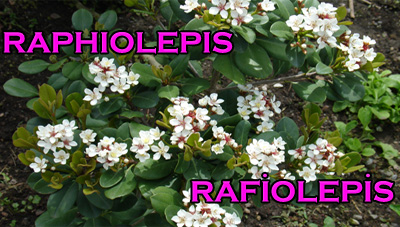 |
|
RAPHİOLEPİS (Indian
Hawthorn)
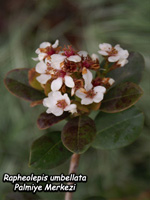
The Raphiolepis are members of the Rosaceae
family. They originate from southeast and east
Asia and despite the fact that they are classified as
sub-tropical plants, they are totally hardy. There
are around 10 types, all evergreen shrubs. In
general rather than growing tall they tend to form
clumps or mounds. They have thick, shiny, dark
green leaves depending on the variety they can measure
up to 8cm in length with a width of up to 4cm. The
star-like flowers have 5 petals, are scented and appear
in spring or early summer.
Raphiolepis umbellata
comes from Japan and Korea. It has hard, shiny,
dark green leaves with slightly serrated edges, reaching
8 9cm in length. The flowers appear in hanging
clusters on stems up to 10cm
 long.
They have 5 petals, are white and sweetly scented.
Sometimes the edges of the flowers are rose pink.
This shrub grows to 1.5m in height and can withstand
temperatures down to -100C. long.
They have 5 petals, are white and sweetly scented.
Sometimes the edges of the flowers are rose pink.
This shrub grows to 1.5m in height and can withstand
temperatures down to -100C.
Raphiolepis indica
whose name could indicate Indian origins, in fact comes
from China. The leaves are slightly smaller and
thinner than those of R.umbellata. The
flowers also bloom on slightly shorter stems, 7 8cm
and have pink centres. Flowers open in spring.
This shrub can also reach a height of 1.5m with its
foliage reaching 1.2m in diameter. It can
withstand frost but is not as hardy as
R.umbellata.
KR.
x delacourii
is a hybrid formed from breeding Raphiolepis
umbellata and Raphiolepis indica. The main
difference from the other two species is its leaves are
slightly shorter and it has pink flowers 2cm in
diameter. It is as hardy as R.umbellata.
Raphiolepis
should be grown in moist, free draining soil into which
organic matter has been worked. They are equally
happy in full sun or partial shade. In a
Mediterranean climate, to avoid an excessive need for
watering, we recommend they be grown in partial shade.
They should be fed once per month during their growing
season. They can be grown in pots but need regular
feeding with long acting fertiliser. |
|
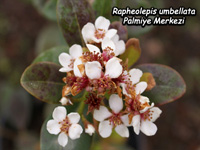 |
|
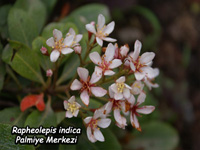 |
|
Palm Centre Plant of the
Month
March 2008 |
|
This month we present a plant which, although found in
this country, has not yet been fully appreciated in
terms of the range of species available, and its value
within planting schemes. The Canna offers a range
of colours and flower shapes, together with broad green,
purple or variegated leaves. It will repeat flower all
through the summer and bring a touch of the tropics to
any garden. |
|
 |
|
Canna
indica-CannaXgeneralis
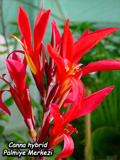 The
Cannas are a group of around 50 varieties belonging to
the Cannaceae. They originate from tropical
regions in India, Asia, and both North and South
America. A special feature they exhibit are the
tall, broad leaves which grow straight up from the
ground. The flowers are also interesting in that they
are asymmetrical, composed of three sepals and three
petals, which are small and hidden under extravagant
stamens. The actual flowers appear within the
bracts and are usually doubles. Cannas grow from
rhizomes and are extremely long-lived plants. The
Cannas are a group of around 50 varieties belonging to
the Cannaceae. They originate from tropical
regions in India, Asia, and both North and South
America. A special feature they exhibit are the
tall, broad leaves which grow straight up from the
ground. The flowers are also interesting in that they
are asymmetrical, composed of three sepals and three
petals, which are small and hidden under extravagant
stamens. The actual flowers appear within the
bracts and are usually doubles. Cannas grow from
rhizomes and are extremely long-lived plants.
As this is a plant beloved of both amateur and
professional gardeners, its popularity has resulted in
the production of hundreds of hybrids. Such
 hybrids
are usually named as canna x generalis. The
original canna is known as canna indica. hybrids
are usually named as canna x generalis. The
original canna is known as canna indica.
lIn
general canna leaves do not withstand frost, but the
rhizomes can take light frosts. In this country,
in areas where only mild frosts can be expected, there
is no need to lift canna bulbs in the autumn. In
regions where winters are more severe, lift the bulbs in
the autumn and store in a frost-free area in a slightly
moist atmosphere.
In terms of garden design, cannas are mainly used in
border planting as single architectural specimens or in
groups. To ensure repeat flowering, when a cluster of
flowers has finished blooming cut the stem at the
bottom. The plant will then form another flower
stem rather than putting its energy into spreading.
|
|
Palm Centre Plant of the
Month
February 2008 |
|
The abutilions are members of the
malvaceae family and are a genus of around 150
varieties some evergreen, some deciduous and
encompassing annuals, perennials, shrubs and small
trees. Most of them come from tropical America but
some are also native to North America, Asia, Africa and
Australia. |
|
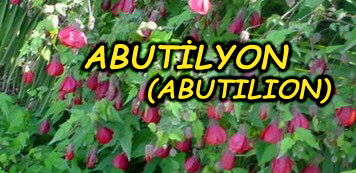 |
|
ABUTILION
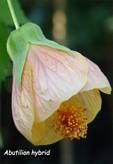
Leaves are usually straight-edged and can be round, oval
or comprised of 3-7 lobes. Flowers are generally
single, bell-shaped and hang down sometimes flowers
are produced in groups. Some species cannot stand
frost whilst others can survive negative temperatures.
They prefer full or part-sun and will flower from early
spring through to winter.
Abutilion are usually kept as glasshouse or indoor
plants in cold climate areas and only take their place
in outdoor garden schemes in tropical or sub-tropical
areas. Propagation can be seed sown in spring or
by cuttings taken year round. As with so many
other plants they prefer well-drained, humus-rich soil.
At the Palm Centre we grow Abutilion pictum,
Abutilion pictum Thompsonii and
Abutilion grandiflora as well as some hybrids.
Abutilion gradiflora Large Leafed Abutilion
is a small tree which can reach a height of 2-3 metres.
Its leaves are round or oval, with slightly serrated
edges. It has yellow, bell-shaped flowers.
It can withstand short periods of frost and for this
reason can be grown outdoors in coastal areas of the
Aegean and Mediterranean.
Abutilion pictum
has green split leaves and orange flowers. The
species known as
Abutilion pictum Thompsonii
or
Abutilion pictum variegata
has variegated leaves caused by the Dwarf Bean Mosaic
Virus which gives the leaves the look of a yellow and
green mosaic. If grown in full sun the yellow on
the leaves becomes more prominent. Because it
looks so attractive this essentially sick plant is
frequently used in landscaping schemes. If
propagated from cuttings the new plants will also have
variegated leaves; if grown from seed a virus-free,
normal, plain green-leafed plant will be produced.
Nowadays plants originating from Central America are
most used in landscaping schemes alongside hybrids which
produce a profusion of flowers thus giving continuous
colour.
|
|
|
Palm Centre Plant of the
Month JANUARY
2008 |
|
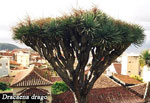 The
Dragons Blood tree has blood red sap from which
it gets its common name. In recent years
scientific research has shown that the blood red sap
contains the same iron element that is found in
haemoglobin in the blood of humans and animals.
Research continues trying to prove that this tree has
evolved from the same source as sentient beings. The
Dragons Blood tree has blood red sap from which
it gets its common name. In recent years
scientific research has shown that the blood red sap
contains the same iron element that is found in
haemoglobin in the blood of humans and animals.
Research continues trying to prove that this tree has
evolved from the same source as sentient beings. |
|
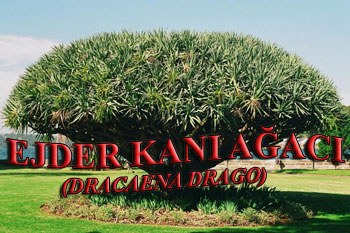 |
|
Dragons
Blood Tree
Dracaena drago
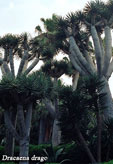 The
Dragons Blood, Dracaena drago is a member
of the evergreen Dracaena family, a group of 40 species
of tree and shrub, found in Africa and Asia. Once
seen the Dragons Blood tree is never forgotten.
Its homeland is the Canary, Madeira and Cape Verde
Islands in the North Atlantic. It is very
long-lived, can grow to 10m in height with a trunk of up
to 1m diameter. The
Dragons Blood, Dracaena drago is a member
of the evergreen Dracaena family, a group of 40 species
of tree and shrub, found in Africa and Asia. Once
seen the Dragons Blood tree is never forgotten.
Its homeland is the Canary, Madeira and Cape Verde
Islands in the North Atlantic. It is very
long-lived, can grow to 10m in height with a trunk of up
to 1m diameter.
On Tenerife, one of the Canary Islands, there is a
specimen said to be 2000 years old. Until three
years ago when age-testing took place the tree was
believed to be a mere 950 years old and the news of its
actual age has had a great impact on the village of Icod
where
it is growing. Bus loads of tourists arrive daily
to view the venerable tree and the village has
 now
become a centre for tourism. The village square,
where the tree is located, has now been planted up as a
mini botanic garden and the whole village declared
traffic free to protect the plants. now
become a centre for tourism. The village square,
where the tree is located, has now been planted up as a
mini botanic garden and the whole village declared
traffic free to protect the plants.
The Dragons Blood tree needs a subtropical
climate to thrive although it can withstand temperatures
down to -40C for short periods. In our
Mediterranean region it is possible to create a suitable
microclimate,
protected from the north, in which to grow this tree.
It has leaves up to 60cm in length, oval shaped and
growing in the form of rosettes. Young trees
resemble a form of agave. For 10-15 years the
trunk grows smoothly and then the first flowers appear
and branches start to be formed. Prior to the
formation of branches, in its initial growing period, it
resembles a palm.
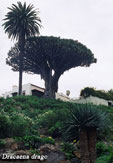 The
flowers appear in spring and are green with
white-bordered panicles, these later become
orange-coloured fruits. The
flowers appear in spring and are green with
white-bordered panicles, these later become
orange-coloured fruits.
The Dragons Blood tree is grown from seed, at
the
Palm Centre we have some four-year-old specimens grown
this way. It likes full sun or part shade and
isnt fussy about soil type but needs goods drainage and
regular watering.
The blood red sap is said to have been smeared on house
doors to prevent nightmares. The sap when reduced
to resin is said to have been used to cover wounds and
prevent bleeding also to stop post-natal bleeding.
These days the sap is used in the production of varnish
and wood stains. |
|

